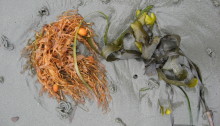The tidal pools of Tongue Point Marine Life Sanctuary at Salt Creek Recreation Area are among the best in the Pacific Northwest. When you stand beneath the Douglas firs on the coastal edge at low tide, acres of intertidal pools lie between you and the Straits of Juan de Fuca. If the fog isn’t obscuring your vision, you can discern the outlines of passing cruise ships and Vancouver Island in Canada. We camped at Salt Creek for four days while exploring the local marine life and the abandoned fort and pillboxes nearby. Chris’s parents joined us on this first leg of our trip.
Accompanied by two marine biologists, Chris’s parents, we set out every morning to Tongue Point to explore the nearby intertidal zone at one of the lowest tides of the year.
We started at the low tide fringe where the waves were breaking as the tide rose. The range of marine critters within the tidal pools varies from the littoral to subidal zones. In the zone 4 tidal pool above, you can see purple sea urchins (Strongylocentrotus purpuratus), green sea anenomes (Anthopleura xanthogrammica), and kelp. The anenomes recoil upon human touch and blossom beautifully when submerged.
Limpets, horse barnacles, and red encrusted algae can be seen in this tidal pool. We also found tide pool sculpen, clingfish, sea cucumbers, gumboot chiton, and various species of starfish nearby.
When you pass by the gooseneck barnacles, you can sometimes hear them whistling.
This island is accessible at low tide only. We explored its perimeter for octupus in vain but instead found robin eggs among the island’s ferns.
From the island, we sighted a bald eagle (Haliaeetus leucocephalus) being harassed by a throng of shorebirds.
Lugworms (Arenicola marina) are responsible for the coiled sand castings that surround the colorful kelp.
VIDEO
In the video, a red sea urchin (Strongylocentrotus franciscanus) uses its spines to crawl across Chris’s hands. One of the longest-lived species, the red sea urchin has radial symmetry along five planes.
*Special thanks to friends Anne and Dave for securing a much sought after campsite at Salt Creek and offering invaluable advice for our southbound journey.









Nice pictures
Reminds me of the Bay of Fundi. The little creatures that live in the tidal pools are amazing in their ability to deal with the radically changing eco-sphere.
Here is a Salt Creek ditty. http://theblackberrybushes.com/?page_id=36
The Salt Creek camping was a ton of fun. Hope we can do that with you again! I remain hopeful to pull an octopi out from its hiding place!